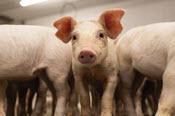
Entering the nursery can be a stressful period for young pigs. Industry experts provide insight on how to get your herd off to a strong start.
By Kate Ayers
Meeting new people, trying new food, and exploring a new destination can be exciting but daunting experiences that we encounter. Now imagine combining all three experiences into one day.
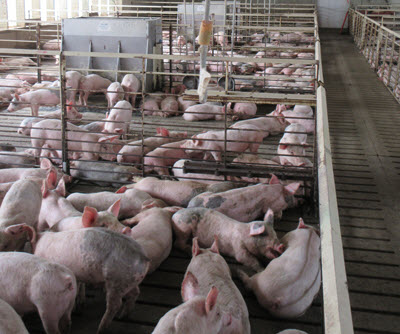
It would be justifiable for anyone to feel apprehension about leaving the comforts of home for so much “newness.” Young pigs face new litter mates, feed and environments when they enter the nursery. These stimuli can be inherently overwhelming and stressful.
Fortunately, swine producers work hard to ensure the health of their herds and provide a smooth transition into the nursery.
Success in the nursery can be attributed to supporting the development of “bulletproof pigs that get off to a good start, have a lot of antibodies, and can handle the immune challenges that they face in the nursery. Piglets that have antibodies are often less susceptible to scours at farrowing and post-weaning in the barns,” says Dr. Laura Bruner, a veterinarian at the Swine Vet Center in St. Peter, Minnesota.
“After weaning, we want the piglets to just focus on eating, not rotavirus, strep or any other diseases. We want them to hit the ground running. So, preparing for the nursery phase is important.”
This month, Better Pork speaks with Bruner, swine nutritionists, and other sector specialists to learn how pork producers can level up their nursery management skills and overcome pig health challenges during this critical production phase.
Before the nursery
Optimizing health and performance in the nursery begins in the farrowing room and, more specifically, originates from sow comfort and milk production.
“This process starts six weeks before the piglets are born. We get the sow ready to produce the highest amount of antibodies that she can and make sure she is in the right condition, so that when the piglets are born, they are set up for success,” Bruner says.
Colostrum antibodies help prepare the piglets for farrowing and then the transition into the nursery.
Once the piglets are born, “make sure sows are eating well and producing lots of milk to optimize piglet growth while they are still suckling,” says Dr. Lee-Anne Huber. She’s an assistant professor in the department of animal biosciences at the University of Guelph in Ontario. Her research focuses on swine nutrition.
Producers can help “piglets prepare for life without mom and the comforts of the farrowing crates,” says Dennis Robles, the production specialist for Swine Health Professionals in Steinbach, Man. The company helps producers develop herd health plans, monitor production progress, and maintain biosecurity targets.
For example, “exposure to small amounts of creep feed after their second week of life will help familiarize the piglets with the first-stage ration that they will get in the nursery,” says Dr. Tim Blackwell. He’s a lead veterinarian in the animal health and welfare branch of the Ontario Ministry of Agriculture, Food and Rural Affairs and is based in Elora, Ont.
Huber agrees that creep feed can help make nursery transition easier for piglets.
Producers can “offer a highly digestible and palatable diet to the piglets that only they can access. The young pigs can then learn how to eat away from the sow.
“Not all piglets will participate and, if they do, it does not always translate to heavier weaning weights. Typically, though, piglets that do eat creep feed will have higher feed intakes after weaning,” she says.
Indeed, “heavier pigs at weaning will reach market weight sooner than lighter pigs,” Huber says.
“An old rule of thumb is that if a piglet weighs 100 grams (3.5 ounces) heavier at weaning, it will reach market weight half to a full day sooner than lighter pigs. This fact motivates us to set up pigs with solid weaning weights.
“In addition to creep feeding, producers can provide piglets in the farrowing room with a water source, such as a cup or nipple drinker that is close to the floor. The drinker teaches piglets that feed and water don’t always come from the same place as it does when they suckle the sow. If you can teach them that aspect ahead of time, you’re already a step ahead,” Huber says.
Weaning age can also play a significant role in the well-being and success of piglets in the nursery.
“Wean age is huge. The older the pig, the better it handles stress of transitioning from farrowing to the nursery,” Bruner says. “And the better the pig takes off in the nursery.”
Traditionally, weaning age is 21 days, but shifting to 24 days, for example, can help piglets put on more weight and thrive in the nursery, says Dr. Crystal Levesque, an associate professor of swine nutrition at South Dakota State University.
In operations that require transportation to another farm location, staff members can help reduce weaning stress through gentle handling, “moving pigs in a calm manner, preventing overcrowding, and loading them into a clean, disinfected and dried or baked trailer,” Robles says.
Clean and chemical-free shavings are better for footing, and trailers should have appropriate covers to protect the pigs from outside conditions, he adds.
Before piglets enter the nursery barn, producers should take extra care ensuring that “the room has been adequately washed, disinfected and dried before a new group of weaned pigs arrives. Farmers should be attentive to the removal of organic materials on floors, walls, pen dividers, gates and pins, and other surfaces,” Robles says.
Producers must use “disinfectants according to manufacturers’ accurate dosages and allow enough time for the disinfectant to work effectively. Also, never underestimate the process of drying the room or barn to provide the new batch of pigs with a truly clean environment.”
As part of pen or barn preparation, temperature is also an important factor to consider. “A day before the pigs arrive, warm the room to the nursery entry temperature, which is between 29 and 31 C (84 and 88 F). This preparation will help them get off to a great start. Indeed, correct ventilation and environmental settings must be in place even before the first hoof steps into the barn,” Robles says.
Solid start
Newly weaned piglets may experience environmental, social, nutritional and physiological stressors during their transition to the nursery. As a result, producers should keep watchful eyes on their newcomers to identify piglets that may get off to a slow start.
“The first two to three days in the nursery are the most critical as the piglets adjust to a new environment,” Blackwell says.
Producers can use qualitative or quantitative measurements to monitor pig health and progress, he says.
“My favourite metric is feed intake. Depending on the weaning age, which is commonly around 21 days, I like to see 400 grams (14 ounces) of feed disappear per pig in the first 48 hours. A little bit more if you wean them later and a little bit less if you wean them earlier,” Blackwell says.
Studies show “that 85 per cent of newly weaned pigs take approximately 35 hours to find water and 90 per cent of them take 30 hours to find feed,” Robles says.
Indeed, some pigs may go without food for a substantial duration, Levesque says. “This length of time without anything going into the gut can increase risks of diarrhea, infections, coughs, or flu. It doesn’t take long for the gut to weaken,” she says.
To ensure that pigs consume enough feed and water as soon as possible after entering the nursery, farmers can use several tactics.
One approach is to wait a couple hours and allow the piglets to settle into their new home before feeding the pigs their first meal.
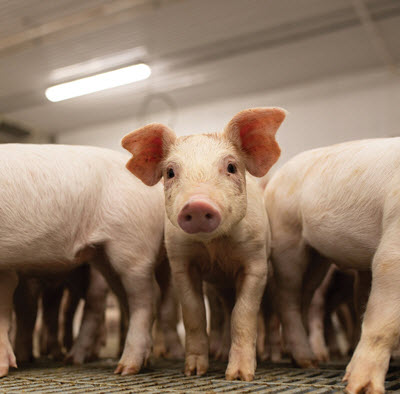
“When piglets are weaned from litters into bigger pens with multiple litters, there is an enormous amount of distractions for them. They investigate the pen and pen mates and figure out where the water and heat are located,” Blackwell says.
“There are just too many other distractions in those first two or three hours. If feed is already in the feeder, it gets stale and the pigs don’t key in on it because there are so many other things going on.”
Mat feeding can help piglets find feed and become more comfortable.
During “the first five to seven days in the nursery, this feeding strategy allows the pigs to sort through the feed. In farrowing, eating is a social event. So, if pen mates see pigs gathering in one spot, they’ll be curious and want to see what is going on,” Bruner says.
Pigs also become accustomed to a signal at feeding time.
“For the first few days, that signal could be a caretaker coming into the pen to deposit feed. Staff members can then more easily identify pigs that are laying down or not interested in the feed, and you can provide additional support to those pigs,” Blackwell says.
Farmers who closely monitor their herds can identify lighter or weaker pigs and provide the extra care they need to thrive.
“Curious and hungry pigs who ate creep feed will come up to the feeder pretty quickly. They will encourage other pigs to come up with them. This time is a good opportunity for producers to see which pigs do not come up to the feeder and to help them,” Blackwell says.
“If you have a group of lighter pigs, they should go in their own pen. You can keep an extra eye on those animals,” he says.
Feed types
The number 1 factor to get piglets off to a solid start in the nursery is to get them to eat, many experts say. To ensure that piglets consume adequate levels of nutrients, the feed must taste good and be fresh.
Typically, nursery diets are highly palatable with high inclusions of “animal proteins, such as fish meal or milk products, which help piglets transition from a milk-based diet to solid feed that is primarily made up of plant protein,” Huber says.
Producers must examine nutritional, feed and management factors in their operations and identify any gaps or areas that they can improve.
“After piglets are weaned, they often experience a post-weaning growth lag” from stress and changes in diet and the environment, Huber says. “They also have immature digestive tracts. Their stomachs are not as acidic as older pigs, and their digestive enzymes are not as active.
“If you can shorten that post-weaning growth-lag period, pigs may reach a heavier weight sooner and could have higher exit weights,” she says.
“Producers can use feed additives to promote nutrient absorption and gut health development. Such products may include acidifiers, prebiotics, and exogenous enzymes. But definitely consult with your nutritionist before making any changes.”
Feeder hygiene and dispensing mechanisms are also important.
Producers must ensure feed is fresh and not caked onto the feeder, Huber says. Increasing the frequency of feed delivery can also help stimulate intake.
In addition, “make sure feeder pan coverage is approximately 50 per cent,” Huber says.
“You don’t want the feeder pan to be overflowing because the excess feed could build up in the corners, but you also don’t want the feeder to be too scarce because you want feed to be present when the pigs go looking for it.”
More feeder space for each pig could help smaller and quieter pigs access feed without getting bullied out of the way, Blackwell’s research team recently found.
“An inch and a half to two inches (3.8 to 5.0 centimetres) of feeder space per pig will ensure they do not have restricted feed intake,” Blackwell says.
“One inch (2.5 cm) per pig may be adequate for the first two or three weeks after weaning, but for the next three or four weeks, when the pigs put on more weight, more feeder space is better. Adding another 50 per cent of feeder space costs between $0.05 and $0.10 per pig over the lifetime of the feeder. You easily get that back in added weight – particularly for the quieter and less aggressive pigs who don’t want to push their way in.”
Another strategy producers can use to reduce post-weaning lag growth and feed costs is to take advantage of compensatory growth, a recent study showed. “Healthy pigs can exhibit compensatory growth after a period of feeding them a less digestible diet, such as a corn- or soybean-based ration, instead of a diet with lots of animal protein,” Huber says.
“Their growth will slow down early in the nursery but then their growth accelerates, and they can achieve the same exit weight as piglets fed a conventional nursery diet. This approach can be a way to reduce feed costs in the nursery, too.”
Overcome nursery challenges
Hog producers can use technology and work with their teams to address issues and promote pig performance in nurseries.
“Always have an accurate data recording system and room monitoring datasheets that provide information on the number of pigs in the nursery, date of entry, age of animals, treatment provisions, mortality and incidence of disease,” Robles says.
Producers can also collect information on out-of-feed-or-water events, storms and power outages that pertain to each batch of pigs, he says.
Measure “entry weights of every batch of pigs. Have another weigh-in at the mid-nursery stage to know if they are growing according to the growth curves you expect and project.
“Your veterinarian, feed nutritionist or production specialist can help you understand reasons why the animals may not be growing as projected.
“On exit, knowing how the group performed throughout the nursery can help you compare and improve on subsequent batches you bring into the barn,” Robles says.
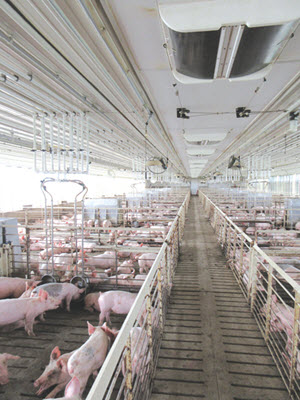
Indeed, nursery management is like a “Jenga puzzle. Every time you miss feedback, feed intake, or temperatures in the barns, for example, a block comes out of that Jenga tower,” Bruner says.
“It is crucial to make sure all the pieces are stacked properly” throughout this production stage.
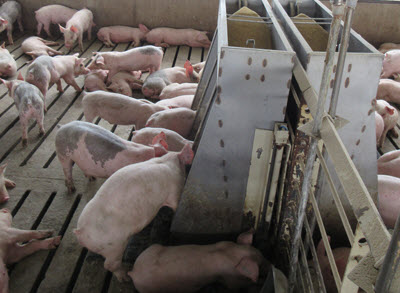
As a result, perhaps the most important piece in the nursery production puzzle is to “maximize feed intake in those first two to three days after young pigs enter the nursery,” Blackwell says.
Overall, “every barn has its own set of challenges,” Robles says.
“But the universal truth about having great biosecurity to prevent entry of diseases, sourcing animals from a high-health-status herd and following herd veterinary guidelines are the main focus areas to work on” to mitigate challenges and promote optimal animal performance, Robles says. BP



Post new comment